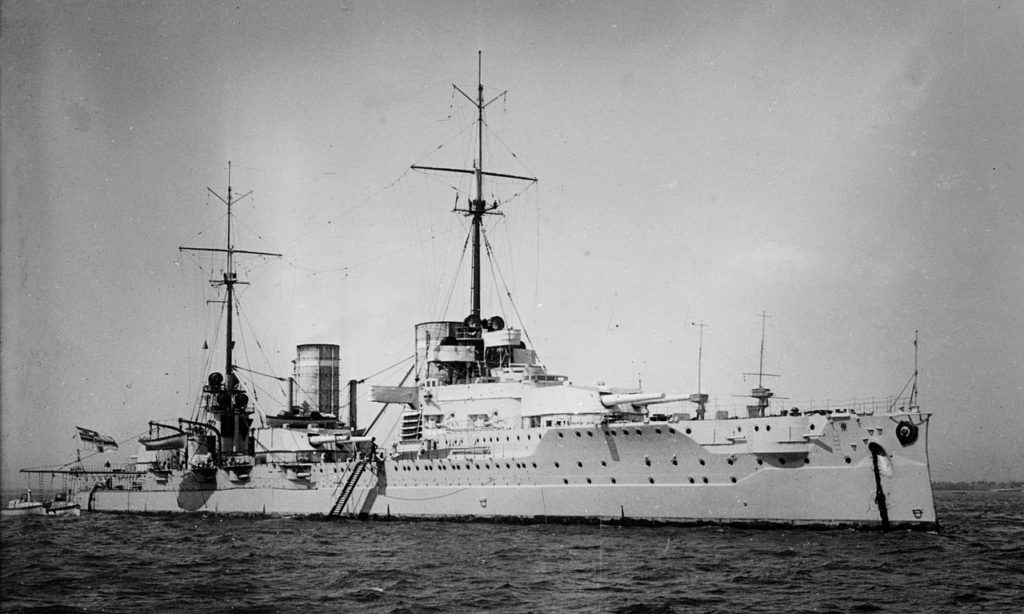
Foreword: German battlecruisers:
The German Empire was the second country after the British Empire to massively invest in battlecruisers. Neither the US, caught late by the war, France, which naval plan of 1912 was halted, Italy, which preferred to focus on dreadnoughts missed the race. Only Japan, closely related to the UK, considered the type enough to order the first two in UK (the Kongo class), the remainder being built at home.
Early Developments: The Blücher
Like for dreadnoughts, the German Empire move to battlecruisers was a matter of pride and rivalry for Wilhelm II, which not to be undone, ordered the Blücher, already in construction, to be modified, as soon as the construction of HMS Invincible was known. The Blücher was designed as an armoured cruiser, a development of the Scharnhorst class launched in 1906. Designed in 1906, Blücher, which construction started at Kiel on February 1907 was much larger and armed with a monocaliber arrangement, like dreadnoughts. This was less a response to the Invincible (which has 12-in guns, versus Blücher’s 8.2 in) than an inspiration from Cuniberti ideas published in 1903 for an armoured cruiser.
Blücher resembled a narrower, longer version of the Nassau class, with the same artillery repartition: One turret fore and aft, two turrets on either side, for a 8-guns broadside. Only the weak armament made her miss the denomination of “battlecruiser”. For most authors she was a monocaliber armoured cruiser, quite a unique proposition at that time. The British were in 1906 also building near-monocaliber cruisers such as the Minotaur class, mixing 9.2 and 7.5 in guns in turrets. Of course German engineers would revise considerably the design to integrate standard heavy caliber (the 11.1 in or 28 cm) on the next iteration, the Von der Tann, the first of the seven German battlecruisers built over ten years.
The race is on
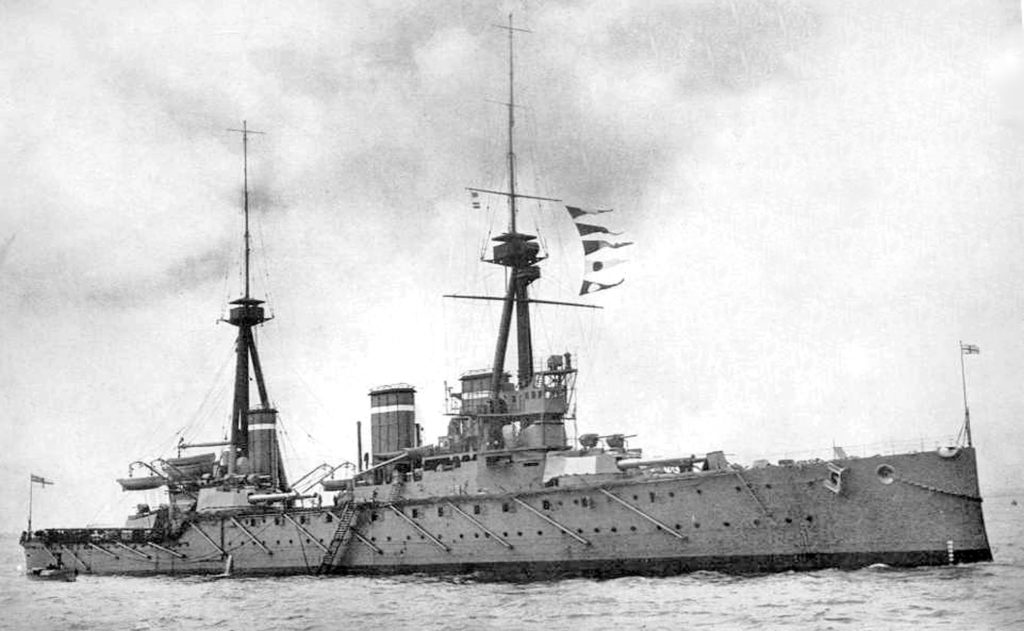
Once HMS Invincible’s construction in mid-1906 was revealed to German authorities (and soon other admiralties around the world), this came as a shock. Right after the Dreadnought was launched in February, she has been laid down at Armstrong Whitworth in April. Another idea of admiral and first lord of the admiralty Sir “Jackie” Fisher, the type was just an evolution of the previous Minotaur class to not wake up suspicion, being called officially an armoured cruiser until 1911 when the denomination was officially changed to battlecruiser. That’s why so many countries were caught off guard, leaving some advance to the Royal Navy.
Germany took notice only thanks to spying, having a clue of the monocaliber configuration. This immediately triggered an alarm for naval planners, more so as two other hulls has been laid down in February and March, at Fairfield and John Brown, for her sister-ships, Indomitable and Inflexible. Nevertheless, the construction of the Blücher, also monocaliber, but with much smaller caliber, was too advanced to seek an upgrade, despite the fact she was laid down one year later, in February 1907.
Indeed plans had been carefully produced over more than a year, and the only way to have the ship upgraded with 28cm guns would have been to stretch the hull in length and width, essentially scaling it up to replace the 21 cm by 28 cm guns. On paper it seemed simple, but it posed in reality quantities of problems which would have delayed her construction for more than a year and a half. Needless to say, having a sufficient powerplant one one of these.
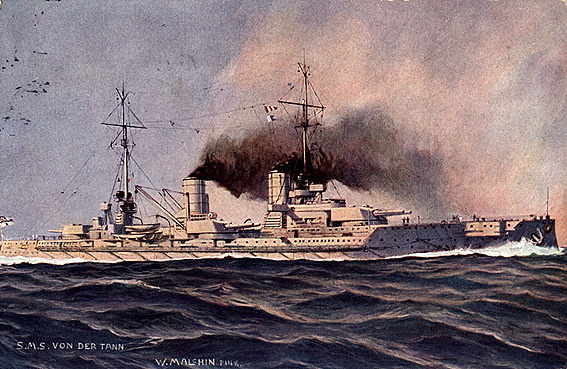
The delay left German engineers with solutions for a true battlecruiser, and the new design came as SMS Von der Tann. She was ordered as part of the FY 1907-08 naval program, s now in full knowledge of the new British BCs. More than that, the Schlachtkreuzer (litt. “battlecruiser”), Von der Tann was a truly brillant design, way superior to the six British battecruiser that have been launched until this point.
From the start, the Kaiserliches Marine strategy was to compensate its inferiority in numbers by the quality of its ships. That was not well known in UK at that time, but gradually this reality started to sweep through during the first naval clashes of the war -during which battlecruisers from both sides were most often committed- until the revelation at Jutland (see below). For stability, the Von de Tann was fitted with Frahm anti-rolling tanks filled with extra coals, lowering the GM at 6.92 feets. To these were added bilge keels.
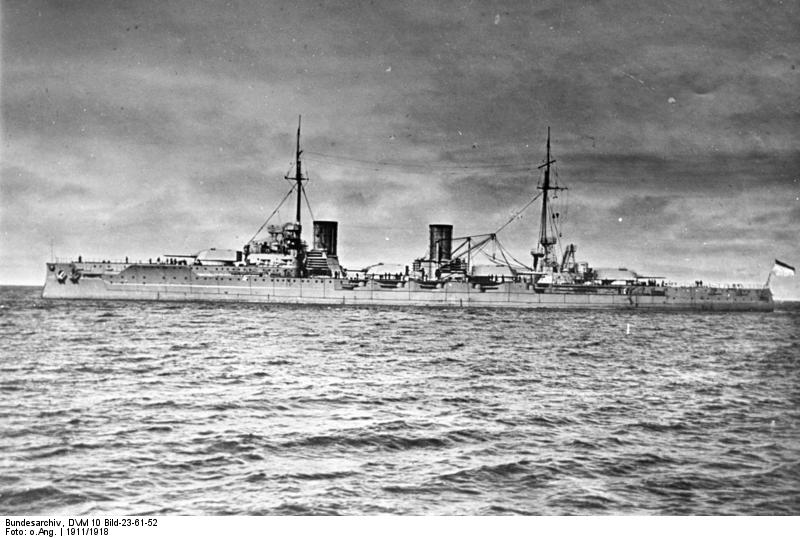
For artillery the solution chosen was the echelon, with just four turrets like and central one in échelon like the British ships. The échelon (lozenge) was used on the first modern ironclads and particularly popular in the 1880s after the early central turrets pairs of masted ironclads of the previous generation. This configuration allowed to fire six guns in chase and retreat, and all in broadside, through at only some angles as the blast of the opposite turret could cause damage to the funnels and superstructure when firing over the deck.
At all times, the safe standard was six also. Secondary armament comprised a set of dependable 15 cm guns (6-in) whereas the British Invincible and Indefatigable had far weaker (but faster firing, and more) 4-in (102 mm) guns. But it was truly for protection that the Von de Tann shined brightly, with 180, 230 or 250 mm in most sensitive areas, and the whole ship protected, whereas the British battlecruisers had 178 mm at best, and no protection in many places, but the conning tower (10-in/254 mm).
When she was completed in February 1911 however, the British admiralty took the next step forward after two classes of relatively similar vessels: The “big cats” serie was born, reflecting the advances in Dreadnoughts as well, the contemporary King Georges V class notably. They adopted 13.5-inch (343 mm) guns, but keeping the same numbers, four turrets, eight guns. But by then, axial fire maximize their effects, and this solution was chosen for the Lion, Princess Royal, and later the Queen Mary. It seems British engineers took notice of the larger caliber and upgraded the level of protection accordingly. It was 9-in (230 mm) in sensitive places and up to 10-in again for the conning tower, with also thicker armour in bulkheads and barbettes. but their secondary armament stayed the same.
They were built at the same time as the first class of German battlecruisers, the Molkte and Goeben. They were planned in 1907 as an upgrade of the Von der Tann, larger to accommodate an extra turret aft. They came better armed than the Lion class, though with much small caliber guns. Protection was still impressive, going as far as 270 mm for the belt. It was roughly the same in values as the Lion class elsewhere although protection was more intensive and covered more areas. They were also smaller than the Lion class, and slower, at 25 knots versus 27.5-28. Goeben would never had the chance to compete with British ships as she was passed under Turkish control soon into the war. But she became overnight the greatest threat for the Russian black sea fleet, and later the allied forces in the Aegean sea. Goeben (Yavuz) proved particularly resilient to mines, being hit two times in 1914 and three times in 1918 and surviving.
Jutland and consequences

The loss of three battlecruisers in a row, Indefatigable, Invincible and Queen Mary, and the Lion which narrowly escaped this, and made wonder David Beatty what was “wrong with the bloody ships”, came as a shock for the British press and shook the parliament as well. All wanted answers, and an enquiry. The “Jutland Scandal” was the subject of one of the most vivid controversy among naval historians to this day.
Bacon explains in the book of the same name, that shells and shell propellant were dangerously exposed, waiting in line to be loaded and fired. Any flash fires could obliterate the whole stock. In principle, Flash doors existed to prevent this, but training practice to gain faster reload times had them left open during the battle. This was confirmed recently as a ship found a wreck and explored it, showing these flash doors were indeed left open.
Also even in the case they would be shut, the heat produced had the cordite in the turret likely ignited. The report from the Gunnery Committee initiated anyway vigorous safety changes in the navy. This was not enough for the Hood though, which mighty explosion cause never had been elucidated well, ans these skills were well integrated into German battlecruisers in 1916.
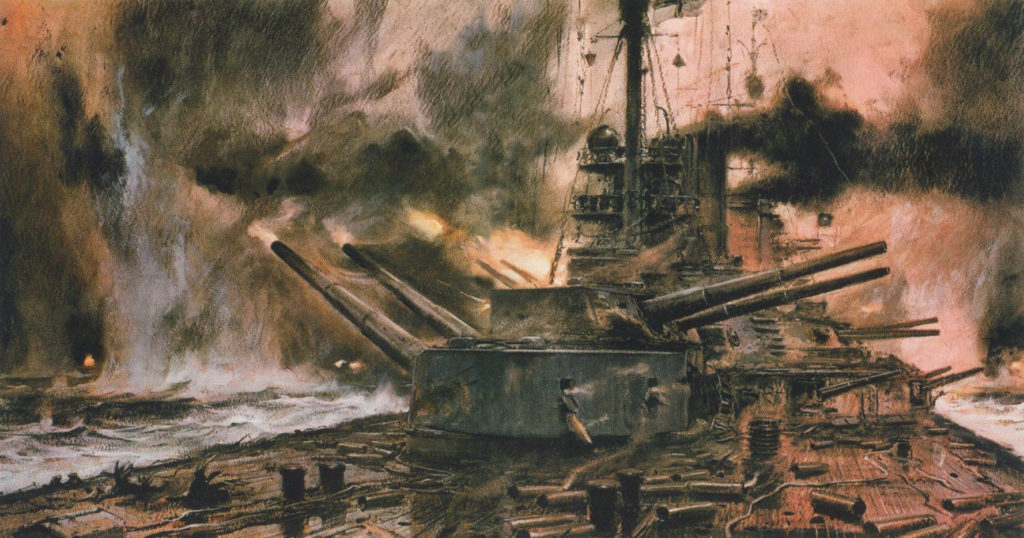
SMS Seydlitz in action at Jutland
All this had nothing to do with some secret brillant technology from the Germans, either super shells, higher velocity or superior accuracy. Both fleets were heavenly match and other factors explained the discrepancy of losses on both sides.
The armour question
Jellicoe however had another theory, in his book about the grand fleet, remarking that “…our ships were very inadequately protected by armour as compared with the German vessels of the battle cruiser type. It was considered undesirable to draw attention to this publicly while the war was in progress.”. Also, the “thin armor” narrative was reported Julian Corbett’s influential “History of the Great War: Naval Operations” (1920).
Jellicoe’s assertions had enough weight to draw Royal engineers to have a clear examination of the Hindenburg, partially immersed in the firth of forth in 1931.
Jellicoe again stated that German ships carried a greater weight of armour, in all positions, including deck protection. By examining details of both navies, it seems indeed, that the British privileged a scheme closer to the “all or nothing”, located over the magazines and engines rooms. A detailed examination of armour schemes by Historian John Roberts went in this sense as well.
One shining example of that was the German battlecruiser Seydlitz winning her duel against HMS Lion at the Dogger Bank, taking a hit, but countered by 250mm of turret armor whereas the Lion’s turret had 230 mm, and had her turret penetrated.
The SMS Seydlitz was saved in extremis from a near-detonation of a magazine, after being hit in the turret by the latter, when the shell propellant was ignited, starting a wild fire. Only activating a valve and flooding the magazines saved the ship. A lesson from Dogger Bank which was well learnt by German staff and crew. This probably resorted to doctrine changes towards flash protection and proper handling of propellant charges throughout the Kaiserliches Marine.
Also more vivid, the comparison between the Derfflinger, also at Jutland, which sported an all-around armor for a total of 37% of her displacement, versus 23% for HMS Lion. Moreover, distances showed the Lion was penetrated from farther away. Therefore the flash problem due to a fast-firing doctrine emphasis was only the consequence of armour discrepancies compared to German battlecruisers, which were also hit quite many times during the battle of Jutland. It could be also said that the Royal Navy traded perhaps ships quality to numbers, to ensure clear superiority over the Kaiserliches Marine, whereas the latter produced unquestionably less battlecruisers, but of overall better quality. The particulars of quality over quantity present in German battlecruisers were also true for aviation at this time, and were still true for tanks in WW2, with perhaps a tendency for over-engineering.
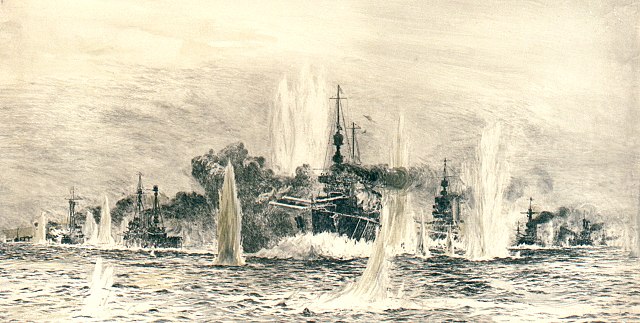
The shell question
Jellicoe also raised another detail, more in line with German armament industry than doctrine or construction: He attributed the better efficience of the German hits to delay-action fuses used, combined with harder armor-piercing caps. A deadly combination which ensured an explosion inside rather than outside the armor, whereas most British shell exploded by contact. This was confirmed by Admiral Mayo, United States admiral which agreed upon Jellicoe’s statements about armor in congressional hearing. Lyddite was used as it was easier and safer to store, but could only be compatible with contact explosions, not delayed fuses.
Director of Naval Construction Eustace H. W. T. d’Eyncourt added that testimonies of German ships obviously hit, with lots of flames, failed to explode as compared to British ships. He explained this paradox by a better internal compartmentation and/or safety systems or measures. This could explain German resilience. Also the use of cordite caused a lot of dark and dense smoke, causing interference for British spotters. To this, the Cordite was found particularly unstable, as shown by tests conducted in 1945 by the USN, igniting at 53 cm from a flash source.
Of course other factors which had nothing to do with German technology were at hand, like the respective positions of the battleline in heavy weather and poor visibility, with the British which happened to be silhouetted against a clear horizon. German battlecruisers then had a clear field of fire.
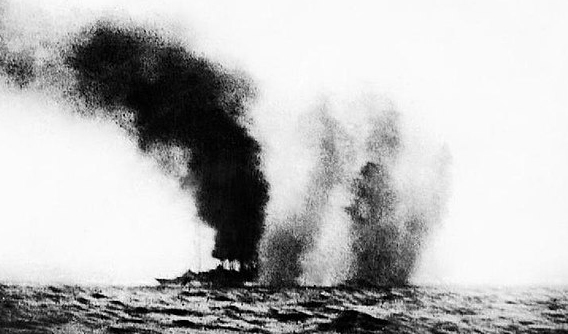
To summup it all, the lessons were certainly harsher for the British that they were for the Germans, but only to prove them the right path they took in ther ship’s design, safety, doctrine, propellant and ammunitions. This had little effect, if any, in the design of their last battlecruisers of the Mackensen class already ready in 1914, but only underline the need for bigger guns, reported on the next Ersatz Yorck class.
Nevertheless, engineer Ernest Cox (Cox & Danks Shipbreaking Co.) successfully raised 35 ships of the German Imperial Navy High Seas Fleet that had been scuttled at Gutter Sound, Scapa Flow, in 1919. He notably raised the German battlecruisers SMS Moltke, SMS Seydlitz, SMS Von der Tann, and SMS Hindenburg, and even proposed to the admiralty to purchase them either for target practice or to found them other uses. Did the Washington treaty limitations have never existed, it is likely these formidable war prizes would have been “recycled” into the Royal Navy, leading to fascinating what-ifs. It is sad however that the Yavuz was never investigated properly by foreign engineers after she was sold for BU in the 1970s. Additional valuable clues could have been gained about German battlecruiser design.
Armament of German Battlecruisers
28 cm/45 (11″) SK L/45 (1909)
Used to on the first German Dreadnoughts and the battlecruiser Von der Tann. This was enough to sink the HMS Indefatigable at Jutland. These guns, which exact bore was 28.3 cm (11.1″), were recycled as coastal artillery on the Atlantic wall during ww2. They were manufactured with an A tube, with two layers of hoops and a jacket ad were fitted with the Krupp horizontal sliding wedge breech block. The gun weighted 87,743 lbs. (39,800 kg). Its rpm was 3 rounds per minute on average. It fired either the APC L/3,2: 662.9 lbs. (300.7 kg) 2a or HE L/3,6 base fuze: 665.8 lbs. (302.0 kg) shell. Muzzle velocity was around 2,805 fps (855 mps).
28 cm/50 (11″) SK L/50 (1911)
Used on the next generation German battlecruisers of the Moltke and Seydlitz Classes. Amazing barrel life as Yavuz still fired in exercises in the 1960s.
For the first time, the mountings used electric pumps for elevation and the training was all electric. The charges were more powerful and range way better. Also used in coastal artillery in WW2.
Made from an A tube with two layers of hoops and a jacket, Krupp horizontal sliding wedge breech block. 36 were manufactured in all.
The gun weight was 91,491 lbs. (41,500 kg), rpm three rounds/minute, they fired either an APC or HE L/3,6 shell like the previous serie. Muzzle velocity was greater, 887 fps (880 mps).
30.5 cm/50 (12″) SK L/50 (1911)
Used on the Helgoland, Kaiser, König dreadnought classes and the German battlecruisers Derfflinger and Lützow. They claimed notably the HMS Queen Mary and HMS Invincible at Jutland.
The guns weighted 114,309 lbs. (51,850 kg) and they were manufactured by Krupp, shrunk on tubes and hoops with the usual horizontal sliding wedge breech block. Rate of fire was better at 2-3 rounds per minute. They used either the APC L/3,4: 892.9 lbs. (405.0 kg) 3a or the HE L/3,8: 892.9 lbs. (405.0 kg) shell with a Fore 76 lbs. (34.5 kg) RPC/12 and Main Charges of 201 lbs. (91 kg) RPC/12. Muzzle velocity was 2,805 fps (855 mps) and barrel life around 200 rounds.
Secondary armament: The standard 15cm
15 cm/45 (5.9″) SK L/45
This was the great standard for WW1 German battlecruisers and battleships:
An effective and reliable guns also declined into most German cruisers of this generation. It was even used in the first interwar German cruiser Emden equipped during WW2 famous merchant raiders and well as many coastal batteries of the Atlantic wall. Manufactured from an A tube and two layers of hoops with the horizontal sliding wedge breech block. Actual bore was 14.91 cm (5.87 in).
Tertiary armament: The ubiquitous 8,8cm
This famous light caliber gun, used over time in many variants, anti-TB and anti-air, had a better muzzle velocity at each iteration, notably due to increased barrel length. It notably far more powerful than the standard allied 3-in (75 mm) and was present in numbers in dreadnoughts as well as German battlecruisers.
8.8 cm/45 (3.46″) SK/LK/L L/45
The great standard tertiary gun of the German Navy. Its long evolution would led to the legendary, fearsome and ubiquitous tank/plane killer of WW2.
Replaced the 1890s L/30 model, it had similar performance for anti-torpedo warfare and was developed into Germany’s first AAA gun called Flak L/45. In the interwar it had the advantage of using the same same ammunition as the 8.8 cm/45 (3.4″) SK C/30 after modifications.
The gun weight was 5,512 lbs. (2,500 kg), 15 rpm, muzzle velocity 2,133 fps (650 mps), using the HE: 21.5 lbs. (9.75 kg) or 22.05 lbs. (10 kg) shell with a 6.6 lbs. (3.00 kg) RPC/12 charge.
Late German battlecruisers
As the battle of Jutland took place in May 1916, the decisive moment for German battlecruisers during the war, as they scored three kills on their counterparts, showing that the inferior (on paper) 2.8 cm was in reality quite capable. Safety measures were respected on board, marksmanship and optics precision made for more precise hits. Nevertheless, at the time the battle was raging, the Lützow was barely two month old since her commission (March) and the Hindenburg, still fitting-out.
She has been launched in August 1915. Much inspired by the Derfflinger class, she differed by several aspects: Longer, more powerful and faster, with improved mountings for better elevation, reworked tripod legs, reworked protection, two more secondary 15cm guns, rearranged boiler rooms. It was too late to integrate Jutland’s lesson however. But the next class would.
The Mackensen class was one step forward in artillery with 34 cm main guns, and full length forecastle. Design work has started in 1912 and was finalized in 1914 and the first two were laid down in 1915 (January and May), however shortages of materials and manpower delayed construction for two years. SMS Mackensen was launched in april 1917, after Jutland’s lessons could be taken in account. However there was not enough time to implement upgrade so they were very much the last “pre-Jutland types”, although faster, and with more range, they still lacked the ideal firepower.
The next Ersatz Yorck however, featured at last more powerful guns, 38 cm. This need was made clear by the battle. Indeed compared to the initial naval plan of 1914, the blueprints were altered to integrate a heavier main artillery, notably in light of the recent British ships of the Furious and Renown classes. They would be the last German battlecruisers of WW1, but certainly not the last German battlecruisers short, as in 1935 the Kriegsmarine accepted the Scharnhorst class into service. Designed as ultimate commerce raiders, their primary duties were heavy cruisers, and they were fast enough to keep battleships at a distance. The plan Z, approved by Hitler in 1939, just before the war broke out, included twelve battlecruisers.
Read More/Src
//en.wikipedia.org/wiki/List_of_battleships_of_Germany
//en.wikipedia.org/wiki/Anglo-German_naval_arms_race
//www.bbc.com/news/magazine-27641717
//weaponsandwarfare.com/2020/05/08/sms-seydlitz-operational-history-i/
//winstonchurchill.org/publications/finest-hour/finest-hour-177/winston-churchill-new-navalism-2/
//navweaps.com/Weapons/WNGER_Main.php
//medium.com/@marcusmagister/the-loss-of-the-battlecruisers-at-the-battle-of-jutland-an-overview-and-analysis-of-various-b9598770fddb
Castles of Steel: Britain, Germany and the Winning of the Great War. Random House
Seligmann, Matthew (January 2010) – “Intelligence information and the 1909 naval scare: the secret foundations of a public panic”
Roberts, John (1997). Battlecruisers. Annapolis, MD: Naval Institute Press
McCartney, Innes (December 2013). “Jutland 1916: The Archaeology of a Modern Naval Battle
Campbell, John (1998). Jutland: An Analysis of the Fighting.
Burt, R. A. (1986). British Battleships of World War One.
German Battlecruisers nomenclature
The German Empire was the second country after the British Empire to massively invest in battlecruisers. Neither the US, caught late by the war, France, which naval plan of 1912 was halted, Italy, which preferred to focus on dreadnoughts missed the race. Only Japan, closely related to the UK, considered the type enough to order the first two in UK (the Kongo class), the remainder being built at home.
Like for dreadnoughts, German move to battlecruisers was a matter of pride and rivalry for Wilhelm II, which not to be undone, ordered the Blücher, already in construction, to be modified, as soon as the construction of HMS Invincible was known. The Blücher was designed as an armoured cruiser, a development of the Scharnhorst class launched in 1906. Designed in 1906, Blücher, which construction started at Kiel on February 1907 was much larger and armed with a monocaliber arrangement, like dreadnoughts. This was less a response to the Invincible (which has 12-in guns, versus Blücher’s 8.2 in) than an inspiration from Cuniberti ideas published in 1903 for an armoured cruiser.
Blücher resembled a narrower, longer version of the Nassau class, with the same artillery repartition: One turret fore and aft, two turrets on either side, for a 8-guns broadside. Only the weak armament made her miss the denomination of “battlecruiser”. For most authors she was a monocaliber armoured cruiser, quite a unique proposition at that time. The British were in 1906 also building near-monocaliber cruisers such as the Minotaur class, mixing 9.2 and 7.5 in guns in turrets. Of course German engineers would revise considerably the design to integrate standard heavy caliber (the 11.1 in or 28 cm) on the next iteration, the Von der Tann.
SMS Von de Tann (1909)
Design
Probably rightly regarded as the first true battlecruiser of the German navy, the Von der Tann stood out from the Blücher (often referenced as a armoured cruiser) with a consistent heavy artillery of 280 mm pieces in 8 twin turrets, which was the fashion at the time, in échelon in the central position.
The generous space available allowed these central turrets such a clearance to bear a full volley of 8 guns in concert at all time. This unique ship was also seen as superior to the HMS Invincible and HMS Indefatigable of the British navy that adopted the same configuration.
The sixteen 88 mm SKL/45 QF guns were divided into 8 sponsons bow and stern, the other being arranged in deckhouse sponsons front and rear. They were all removed in 1917 and replaced by only two AA 88mm installed at the rear. After tests, the Von der Tann managed to reach 27.6 knots with its boilers giving 79,000 hp.
Career
Apart from a few cruises, including the bombing of British coastal cities in 1914, the Von der Tann came to shine at the battle of Jutland in May 1916: The first 15 minutes of exchanges she sent to the bottom her alter ego, battleship HMS Indefatigable.
Later, however, she was hit four times with large caliber shells, disabling its two aft turrets, while the two forward experienced electrical failures that made the ship still facing mayhem for fifteen minutes with only its secondary battery. After the battle she was stranded at home until the armistice, being led to Scapa Flow and scuttled June 21, 1919, salvaged in December 1931 and demolished.

Illustration of the Von der Tann in 1917
Specifications
Displacement: 19,064 t, 21,700 t FL
Dimensions: 171.6 x 26.6 x 9 m
Propulsion: 4 shaft Parsons turbines, 18 Schultze-Thornycroft boilers, 43,600 hp, 24.7 knots.
Armor: Battery 150, central reduced 180, turrets 230, belt 250, blockhouse 250, barbettes 230 mm
Crew: 1174.
Armament: 8 x 280 (4×2), 10 x 150, 16 x 88, 4 x 450 mm TTs (sub)
Moltke class (1910)
Design
Taking the succession of Von der Tann, the Moltke class (KMS Moltke – KMS Goeben, launched in April 1910 and March 1911, in service in March and August 1912) were very much improved, with a hull with more refined shapes, “prismatic” and a new artillery arrangement with an additional superfiring turret aft (for reasons of stability, because of the height of the forecastle).
Modifications
The new gun’s mounts had a lower elevation, which was later corrected. During the war, two, even four 152 mm guns were removed from SMS Goeben. As for the twelve 88 mm barbettes, they were removed at the end of 1916 and replaced by four 88 mm L/45 Flak instead on the deck. Very good steamers, they ran 28 knots in trials, rated for 85,000 hp. Still at the end of 1916, two new firing stations were added to the reinforced military masts, while additional projectors were placed.
Career
Moltke fought at the Dogger bank in August 1914 and was torpedoed on the 19th by the E3 submersible, without much damage. She managed to hit 6 shots on HMS Tiger during the Battle of Jutland, taking four heavy shots himself without difficulty. On April 24, 1918, however, during a sea trip, a serious turbine accident disintegrated her propeller shaft and caused a 2,000-ton waterway. Immobilized far in the North Sea, she was stopped for repairs for 36 hours, receiving a torpedoed from E42. She survived, however, but was interned at Scapa Flow, and scuttled in 1919, then BU in 1927.
SMS Goeben was the flagship of the Mediterranean squadron in 1914. Surprised by the declaration of war, she steamed to the Dardanelles and joined Turkey. Officially integrated into the Ottoman navy, she made he new career until 1918 fighting the Russians in the Black Sea. She was officially renamed Yavuz Sultan Selim and served until 1971.

Illustration of the Moltke in 1915
Specifications
Displacement: 22,979 t standard, 25,400 t FL
Dimensions: 186.6 x 29.4 x 9.19 m
Propulsion: 4 shaft Parsons turbines, 24 Schultze-Thornycroft boilers, 51,300 hp, 25.5 knots.
Range: 4,120 nmi (7,630 km; 4,740 mi) at 14 knots (26 km/h; 16 mph)
Armor: Belt 280 mm, Barbettes 230 mm, Gun turrets 230 mm, Deck 76 mm
Crew: 1053.
Armament: 10 x 280 (5×2), 12 x 150, 12 x 88, 4 x 500 mm TTs (sub)
Seydlitz (1912)
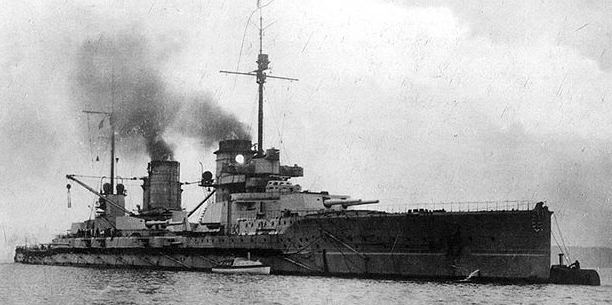
Design
Derived from the German battlecruisers of the Moltke class, Seydlitz differed in many respects. She had a revised hull with three successive steps, and a singular configuration, but with the same arrangement of artillery, again a revised protection, plus three thousand tons more in displacement. Despite of it she was more powerful and faster.
Probably the most modern battlecruiser ever owned a Nation in 1914, SMS Seydlitz proved the excellence of her fire control system at the famous battle of Jutland, taking torpedoes and perhaps 25 hits without sinking, whereas British cruisers blew up at the first salvo.
The “shell magnet”
Her baptism of fire took place at the Battle of Dogger Bank in 1914, against the HMS Lion, conceding three hits that caused a dramatic fire. Repaired, she back into service only to hit a mine in 1916 and again repaired.
At the Battle of Jutland, she was hit by two torpedoes from the destroyers HMS Petard and Turbulent, and above 22 hits including 16 from the British latest fast dreadnoughts (381 mm). Managing to survive miraculously, she barely made it to the German coast, beaching with more than 5,330 tons of seawater its bulkheads.
Again repaired, she reached Scapa Flow like the rest of the Hochseeflotte after the armistice, scuttled it in 1919, and was raised, resold and BU in 1928. The was probably the best and most scarred veteran of German battlecruisers by then.

Illustration of the Seydlitz
Specifications
Dimensions: 200 x 28,5 x 9,2 m
Displacement: 24,600t, 28,100t FL
Crew: 1068
Propulsion: 4 shafts Parsons turbines, 27 Schultze-Thornycroft boilers, 88,500 hp, 26.5 knots
Range: 4,200 nmi (7,800 km; 4,800 mi) at 14 knots (26 km/h; 16 mph)
Armament: 10 x 280 mm (5×2), 12 x 150 mm, 12 x 88 mm
Armor: Battery 200, citadel 220, turrets 251, belt 300, blockhaus 350, barbettes 230 mm
Derfflinger class (1913)

Design and development
Last prewar Germans battle cruisers (on the drawing board, they were completed after the war broke up), they are considered among the best. For the first time, a flush deck was preferred to the three bridges system used by Seydlitz. Their prismatic shape was accentuated, and they had good manoeuvrability. Their protection was also excellent and they “digested” heavy shells with surprising strength: It took no less than 24 hits to destroy Lützow at Jutland.
For the first time these ships were given height 305 mm guns, which at the time still feeble compared to the caliber adopted by Royal Navy equivalents. Therefore, these were still were out-ranged in addition to be out-gunned. Central battery was a bit low and prone to spray, and their protection and compartmentalization under the waterline was not excellent. Both battlecruisers were launched at Hamburg (Blohm & Voss) and Danzig (Schichau) respectively, accepted into service in November 1914, and March 1916.
The Derfflinger in action
The Derfflinger began her tests in March 1915 but underwent teething turbine problems. They managed to achieve 26.4 knots in trials. The Derfflinger fought at the Dogger Bank, conceding three hits, but at Jutland it was another matter: The Queen Mary was hit 11 times by Derfflinger, but she took herself 21 hits (particularly pounded by Revenge 381mm guns), knocking off the two rear turrets. She took 3,300 tons of water, but remained stable due to her ballast, banking only only 2°. She managed to return in Kiel, was repaired, but stayed inactive until out to sail to Scapa Flow, and to her fate.
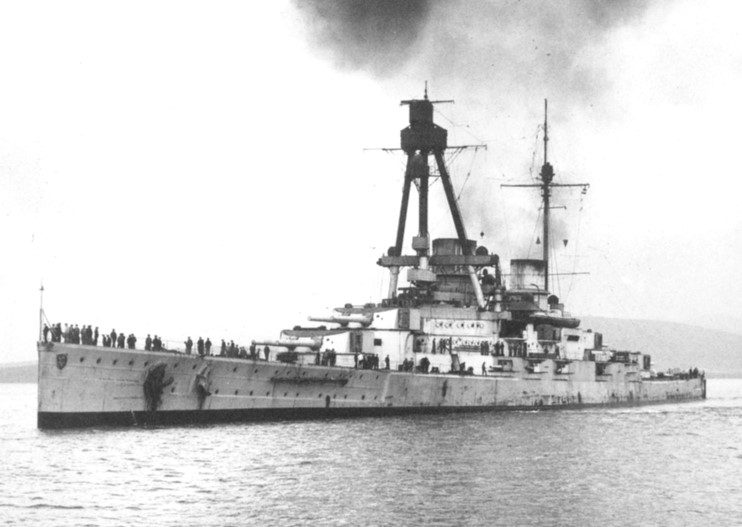
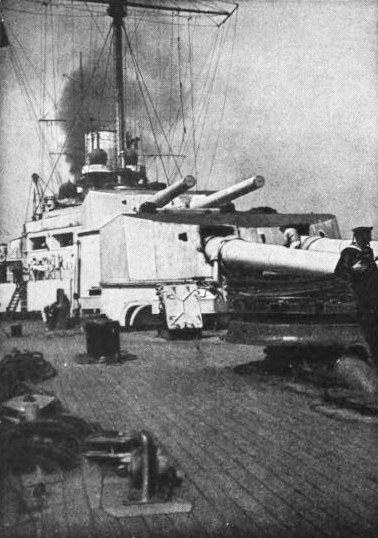 She was salvaged and broken up in 1934. The Lützow has a short career. Due to the war indeed, the yard was deserted, so she was operational only two months before Jutland. She managed to send HMS Invincible to the bottom (conceding two hits herself) and badly damaged HMS Defence before succumbing to a withering fire from other ships, taking 24 impacts of large caliber. Destroyer G38 torpedoes eventually finished her off as she refused to sink. Both were quite formidable German battlecruisers and they proved it time and again.
She was salvaged and broken up in 1934. The Lützow has a short career. Due to the war indeed, the yard was deserted, so she was operational only two months before Jutland. She managed to send HMS Invincible to the bottom (conceding two hits herself) and badly damaged HMS Defence before succumbing to a withering fire from other ships, taking 24 impacts of large caliber. Destroyer G38 torpedoes eventually finished her off as she refused to sink. Both were quite formidable German battlecruisers and they proved it time and again.
Comparison of Lützow and Hindenburg.
Derfflinger/Lützow specifications
Dimensions: 210,4 x 29 x 9,5 m
Displacement: 26,180t, 31,700t FL
Crew: 1390 (wartime)
Propulsion: 4 shafts Parsons turbines, 18 Schultze-Thornycroft boilers, 63 000 hp, 26.5 knots
Range: 5,600 nmi/12 knots
Armament: 4×2 305, 12/14×150, 4/0x 88 AA, 4 TT 500/600mm (2 sides, bow, stern).
Armor: Battery 150, citadel 250, turrets 270, belt 300, blockhaus 350, barbettes 260 mm
SMS Hindenburg (1915)
Design
The Hindenburg was distinguished by an increased length for better hydrodynamics, sturdy tripod mast supporting an imposing fire control but the same armament as the previous Lützow (600 mm TT, 14 x 150mm instead of 12), however it received the new SKL 305/55 designed in the fall 1913 which had a better range. Much more powerful she was a knot faster. The ammunition loading system was also revised and more efficient. Like other ships in the German navy, she run with a mixed of coal and oil.
In action:
Started in June 1913 in Wilhelmshaven, SMS Hindenburg was launched in August 1915 and started trials in May 1917. In November, she was accepted into service. Her career thus barely spanned a year. She did a few raids in the Baltic, but remained mostly inactive until the surrender, and sailed to Scapa Flow to be scuttled in June 1919. In 1930 an official Royal commission of Engineers moved to the ship for a comprehensive study. It was then realized the excellence of her protection, ammunition management systems, modern communication and advanced fire control system. She was probably the most well-thought and refined of all German battlecruisers, a true precursor of fast battleships of the 1930s.
Hindenburg specifications
Dimensions: 212,8 x 29 x 9,4 m
Displacement: 26,500t, 31,000t FL
Crew: 1182
Propulsion: 4 shafts Parsons turbines, 18 Schultze-Thornycroft boilers, 72 000 hp, 26.6 knots
Range: 6,100 nmi (11,300 km; 7,000 mi)/12 knots
Armament: 4×2 305, 14×150, 4x 88 AA, 4 TT 600mm (2 sides, bow, stern).
Armor: Battery 150, citadel 250, turrets 270, belt 300, blockhaus 350, barbettes 260 mm
Mackensen class – The flush-deck German battlecruisers (1917)

Mackensen class 1913 design
These German battlecruisers would have differed from the others in having a full length forecastle deck and a return was made to twin instead of tandem rudders. They would have been handsome ships with tripod foremast and 2 funnels. Mackensen was laid down under the 1914-15 programme, Ersatz Freya under the War estimates and the others were ordered in April 1915. It was originally hoped to complete them from the summer of 1917 to the autumn of 1918, and their 35 cm guns would have made them formidable antagonists.
Ersatz Freya was to have been named Prinz Eitel Friedrich and Ersatz A, later known as Ersatz Friedrich Carl, was to have been named Fürst Bismarck.
The main armament was arranged as in Hindenburg and the Drh LC/1914 mountings allowed 20° elevation, while the 15cm were in a long upper deck battery extending from the forward turret to the after superfiring one. The 5 TTs would have been arranged with one in the bows and two on either broadside forward and aft of the torpedo bulkhead.
The 12in main belt ran from 10ft forward of the fore turret to 10ft abaft the after one and tapered to 6-in at the lower edge and 9-in at the upper deck. Forward and aft the armour stopped short of the ends and was respectively 4in and 4in. The barbettes were reduced to 4 in (Ersatz A 6in) behind the battery armour and to 3-in behind the main belt, while the turrets had 12.8-in faces, 8-in sides, 8-in rears, 7in-4.3in roofs except that in Graf Spee the figures were 12in, 8-in, 8-in-1/2, 6in-4in.
The armour deck did not extend outboard of the torpedo bulkhead amidships where it was 2.4in-1.2in with 2in forward and 4.3in-3.2in aft. The upper deck was 1-in over the main belt and the forecastle deck 2in-lin over the battery. The torpedo bulkhead was 2in increased to 2.4in by the turrets, and continued as a 1.2in splinter bulkhead to the upper deck.
The boilers comprised 24 single-ended coal-fired and 8 double-ended oil-fired and were smaller than in the previous ships. Leak pumps were increased to 8 from 5 in Hindenburg.
Specifications
Displacement: 31,000 t – 35,300 t fully loaded
Dimensions: 223 m x 30.4 m x 9.3 m (731 ft 8 in, 99 ft 9 in, 30 ft 6 in)
Propulsion: 4 shaft geared steam turbines, 32 boilers, 88,769 shp (66,195 kW)
Speed: 28 knots (52 km/h; 32 mph)
Range: 8,000 nmi (15,000 km; 9,200 mi) at 14 knots (26 km/h; 16 mph)
Crew: 46 officers, 1,140 enlisted men
Armament: 8 × 35 cm, 14 × 15 cm , 8 × 8.8 cm, 5 × 60 cm TTs
Armor: Main belt: 100–300 mm, turrets: 270 mm, Deck: 30 to 80 mm, CT: 300 mm
Ersatz Yorck – The ultimate German battlecruisers (1918)

Originally ordered in April 1915 as units of the Mackensen class, the design was altered in January 1917 in an attempt to produce a battlecruiser with 8-38cm guns using machinery already ordered. Appearance would have been quite distinct with the uptakes trunked into a single large funnel.
The main armament was arranged as in Mackensen but the upper deck 15cm battery was lengthened to 413ft with 6 guns from ‘A’ barbette to the CT, 4 by the mainmast and 2 by the aftermost barbette. The bow TT was retained with one on either beam aft of the boiler rooms and thus within the area of the torpedo bulkhead.
Armour was generally as in Mackensen but the main belt tapered to 9-in to 8-in at the upper deck and the barbettes were reduced to 7-in behind the battery and from 4-3/4 inches to 3-1/2 inches behind the belt. The turrets were to have 12in faces, 10in sides, 11 in rears and 10in-6in roofs, while the armour deck was 4in-2.8in aft and the forecastle deck 2in-0.8in.
Construction of Ersatz Yorck was halted after 1000-1100 tons of steel had been assembled.
Specifications
Displacement: 33,500 t / Full load 38,000 t
Dimensions: 227.8 m, 30.4 m , 9.3 m (747 ft 5 in, 99 ft 9 in, 30 ft 6 in)
Propulsion: 4 shaft geared steam turbines 90,000 shp, 32 boilers
Speed: 27.3 knots (50.6 km/h; 31.4 mph)
Range: 5,500 nmi (10,200 km; 6,300 mi) at 14 knots (26 km/h; 16 mph)
Complement: 47 officers + 1,180 sailors
Armament: 8 × 38 cm, 12 × 15 cm, 8 × 8.8 cm, 3 × 60 cm TTs
Armor: Main belt: 100 to 300 mm, Deck: 30 to 80 mm, Turrets: 270 mm, Sec. battery: 150 mm

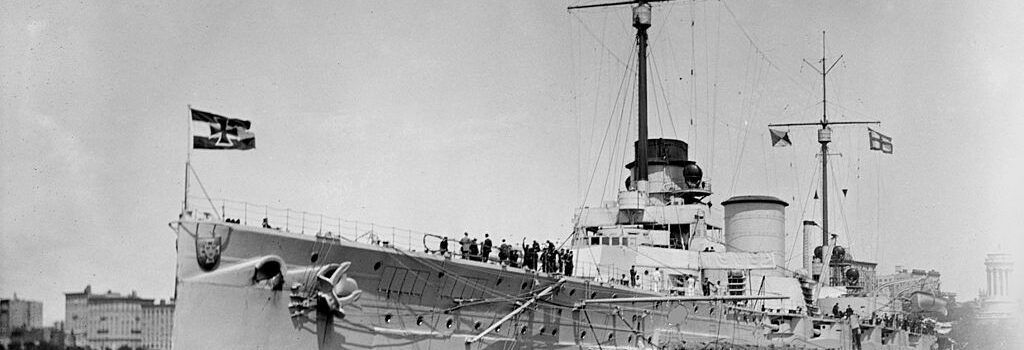

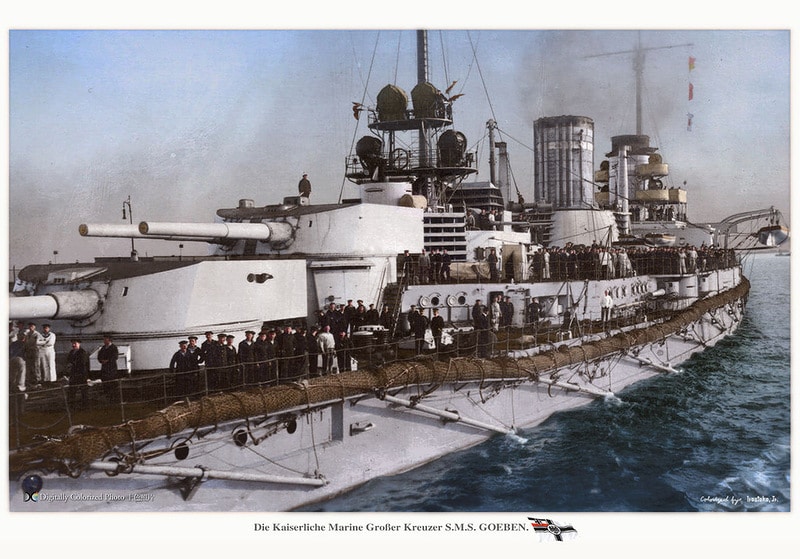
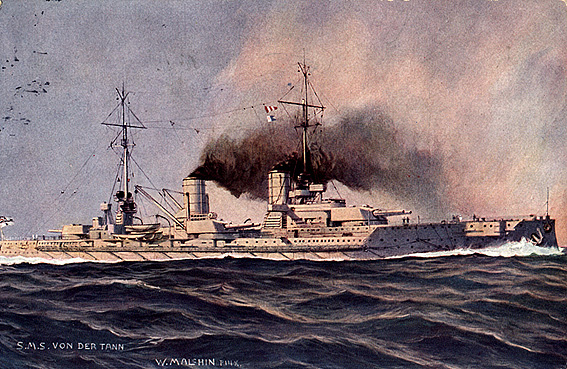
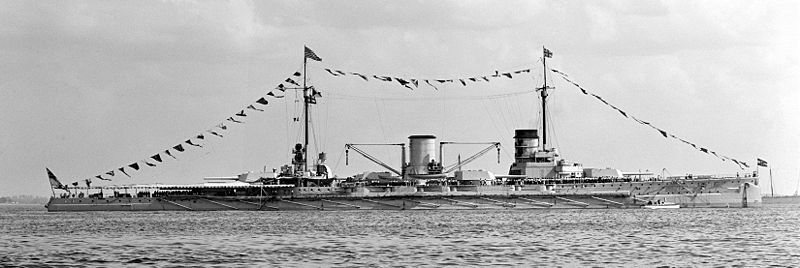


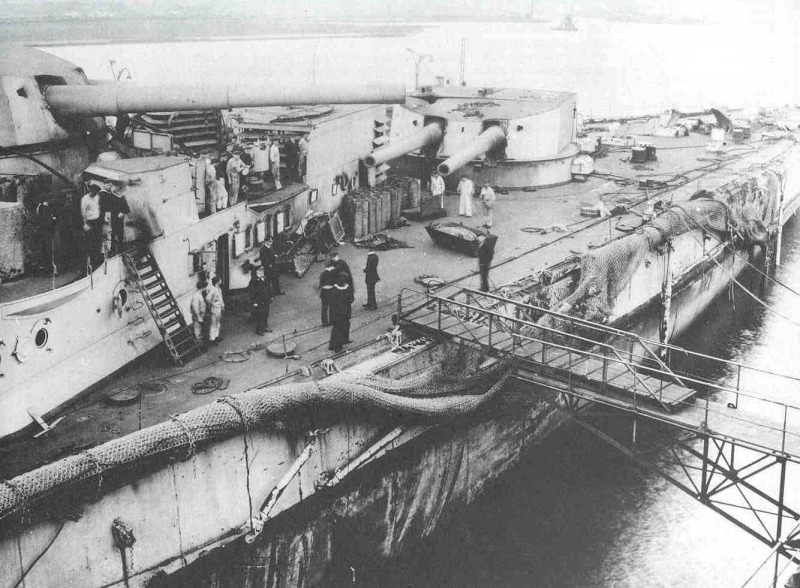
 Latest Facebook Entry -
Latest Facebook Entry -  X(Tweeter) Naval Encyclopedia's deck archive
X(Tweeter) Naval Encyclopedia's deck archive Instagram (@navalencyc)
Instagram (@navalencyc)





 French Navy
French Navy Royal Navy
Royal Navy Russian Navy
Russian Navy Armada Espanola
Armada Espanola Austrian Navy
Austrian Navy K.u.K. Kriegsmarine
K.u.K. Kriegsmarine Dansk Marine
Dansk Marine Nautiko Hellenon
Nautiko Hellenon Koninklije Marine 1870
Koninklije Marine 1870 Marinha do Brasil
Marinha do Brasil Osmanlı Donanması
Osmanlı Donanması Marina Do Peru
Marina Do Peru Marinha do Portugal
Marinha do Portugal Regia Marina 1870
Regia Marina 1870 Nihhon Kaigun 1870
Nihhon Kaigun 1870 Preußische Marine 1870
Preußische Marine 1870 Russkiy Flot 1870
Russkiy Flot 1870 Svenska marinen
Svenska marinen Søværnet
Søværnet Union Navy
Union Navy Confederate Navy
Confederate Navy Armada de Argentina
Armada de Argentina Imperial Chinese Navy
Imperial Chinese Navy Marinha do Portugal
Marinha do Portugal Mexico
Mexico Kaiserliche Marine
Kaiserliche Marine 1898 US Navy
1898 US Navy Sovietskiy Flot
Sovietskiy Flot Royal Canadian Navy
Royal Canadian Navy Royal Australian Navy
Royal Australian Navy RNZN Fleet
RNZN Fleet Chinese Navy 1937
Chinese Navy 1937 Kriegsmarine
Kriegsmarine Chilean Navy
Chilean Navy Danish Navy
Danish Navy Finnish Navy
Finnish Navy Hellenic Navy
Hellenic Navy Polish Navy
Polish Navy Romanian Navy
Romanian Navy Turkish Navy
Turkish Navy Royal Yugoslav Navy
Royal Yugoslav Navy Royal Thai Navy
Royal Thai Navy Minor Navies
Minor Navies Albania
Albania Austria
Austria Belgium
Belgium Columbia
Columbia Costa Rica
Costa Rica Cuba
Cuba Czechoslovakia
Czechoslovakia Dominican Republic
Dominican Republic Haiti
Haiti Hungary
Hungary Honduras
Honduras Estonia
Estonia Iceland
Iceland Eire
Eire Equador
Equador Iran
Iran Iraq
Iraq Latvia
Latvia Liberia
Liberia Lithuania
Lithuania Mandchukuo
Mandchukuo Morocco
Morocco Nicaragua
Nicaragua Persia
Persia San Salvador
San Salvador Sarawak
Sarawak Uruguay
Uruguay Venezuela
Venezuela Zanzibar
Zanzibar Warsaw Pact Navies
Warsaw Pact Navies Bulgaria
Bulgaria Hungary
Hungary

 Bundesmarine
Bundesmarine Dutch Navy
Dutch Navy Hellenic Navy
Hellenic Navy Marina Militare
Marina Militare Yugoslav Navy
Yugoslav Navy Chinese Navy
Chinese Navy Indian Navy
Indian Navy Indonesian Navy
Indonesian Navy JMSDF
JMSDF North Korean Navy
North Korean Navy Pakistani Navy
Pakistani Navy Philippines Navy
Philippines Navy ROKN
ROKN Rep. of Singapore Navy
Rep. of Singapore Navy Taiwanese Navy
Taiwanese Navy IDF Navy
IDF Navy Saudi Navy
Saudi Navy Royal New Zealand Navy
Royal New Zealand Navy Egyptian Navy
Egyptian Navy South African Navy
South African Navy






























 Ukrainian Navy
Ukrainian Navy dbodesign
dbodesign
Are the specs of Moltke class realy the same as Von der Tann ?
Fixed ! Thx for spotting
All said and done, I feel the Derfllinger class were the best battlecruisers of the entire war. They were very well armoured, had an effective main armament and a decent speed. A couple of more of these excellent ships by spring of 1916 would have of more use of the KM than the never completed Mackensens.